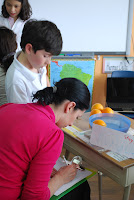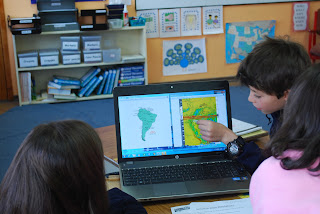 Our “Being Media Smart” PYP Unit (By I.G., A.B., J.B. and
M.D.C.): Hello people from planet Earth! We are reporting from planet Mars.
In planet Mars, we use a lot of technological skills and journalism. We also
broadcast the Mars Incorporated (M.I.) News. Broadcasting is when you tell a
story or the latest news to people all around Mars. Sometimes on planet Mars,
we watch commercials for advertising, and advertising is when you try to sell a
product or when you’re trying to get people to buy your brand. Sometimes we
read the M.I. News, and that’s called journalism, and journalism is when you
write an article about the news going around town. That’s what we do in planet Mars!
Our “Being Media Smart” PYP Unit (By I.G., A.B., J.B. and
M.D.C.): Hello people from planet Earth! We are reporting from planet Mars.
In planet Mars, we use a lot of technological skills and journalism. We also
broadcast the Mars Incorporated (M.I.) News. Broadcasting is when you tell a
story or the latest news to people all around Mars. Sometimes on planet Mars,
we watch commercials for advertising, and advertising is when you try to sell a
product or when you’re trying to get people to buy your brand. Sometimes we
read the M.I. News, and that’s called journalism, and journalism is when you
write an article about the news going around town. That’s what we do in planet Mars!
TC-TV Field Trip (By A.C., E.P., M.M. and. D.G): Hello,
once again, audience! We are going to talk about TC-TV! At TC-TV we had lots of
fun. First they said, “one group at a time’, and the other class was first. We
stayed outside doing class work and playing games. When we were inside, the
tour guide showed us a news studio, and they informed us that they move
furniture and the walls when they change shows. Where they film, the stage also
has to be lit up. They also showed us the sound studio. It had lots of
computers and screens, and the director was telling the people on stage what to
do. Seeing these new and unusual things was extraordinary and we learned a lot.
 ¡Elé! Magazine Field Trip (By E.B., B.A., A. C. G. and D.
G): When we went to ¡elé! Magazine, it was our second filed trip of the
school year. We were so excited! We wanted to do everything in there, but we
needed to calm down or they wouldn’t let us in because there were special
things in there. We saw how the computer
graphics specialists draw on the computer with special software. We saw how
they draw the cartoon enemies of Captain Emblem (“Capitan Escudo”). We also saw
a video of how they create the magazine, and we learned that new technology is
used for all the interesting things that they do.
¡Elé! Magazine Field Trip (By E.B., B.A., A. C. G. and D.
G): When we went to ¡elé! Magazine, it was our second filed trip of the
school year. We were so excited! We wanted to do everything in there, but we
needed to calm down or they wouldn’t let us in because there were special
things in there. We saw how the computer
graphics specialists draw on the computer with special software. We saw how
they draw the cartoon enemies of Captain Emblem (“Capitan Escudo”). We also saw
a video of how they create the magazine, and we learned that new technology is
used for all the interesting things that they do.
Guest Speaker: Mr. Lawrence Informs us About FONAG (By
N.R., E.L., A.S. and M. P): Mr. Lawrence came to our class to give us a
presentation and show us how FONAG works. FONAG stands for “Fondo para la Protección del Agua” and is in Quito,
Ecuador. We learned that FONAG is an organization that helps protect
watersheds around Quito, where people get their water from. They teach people
how to not contaminate the water, and how to conserve it. Did you know that if you add extra money to
your water bill, then you can donate it to support FONAG? So, you should give
more money to FONAG! For more information, see: http://www.fonag.org.ec/inicio/.
































